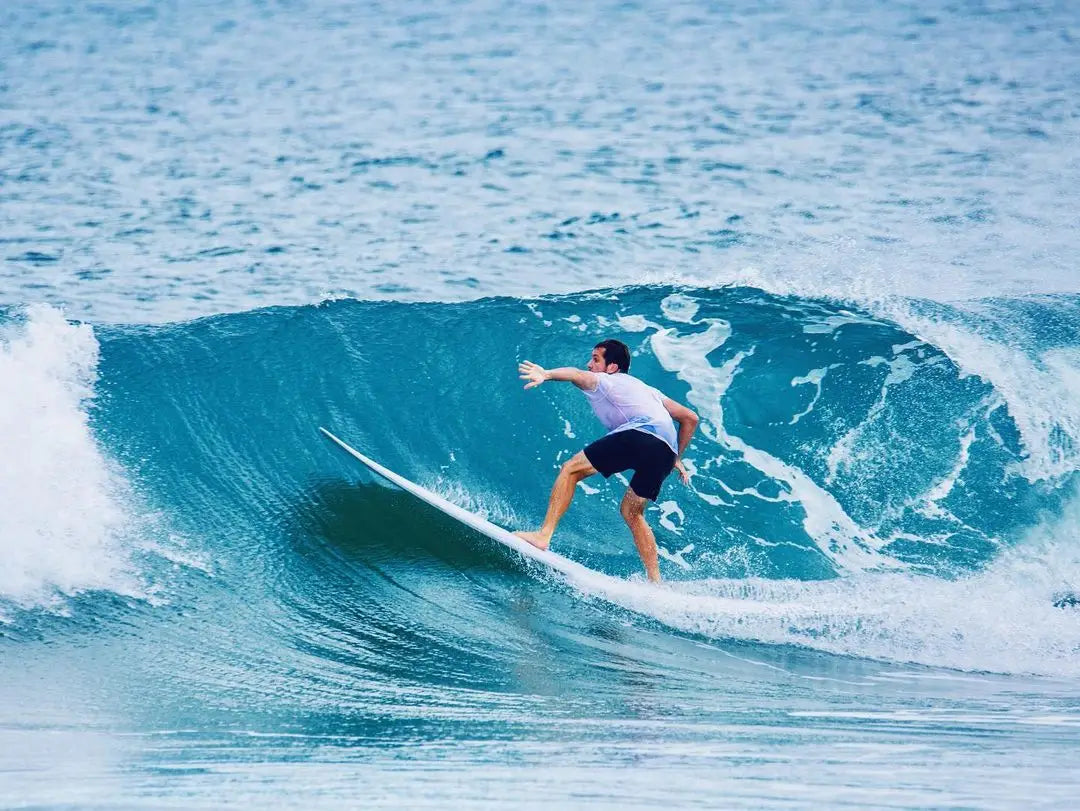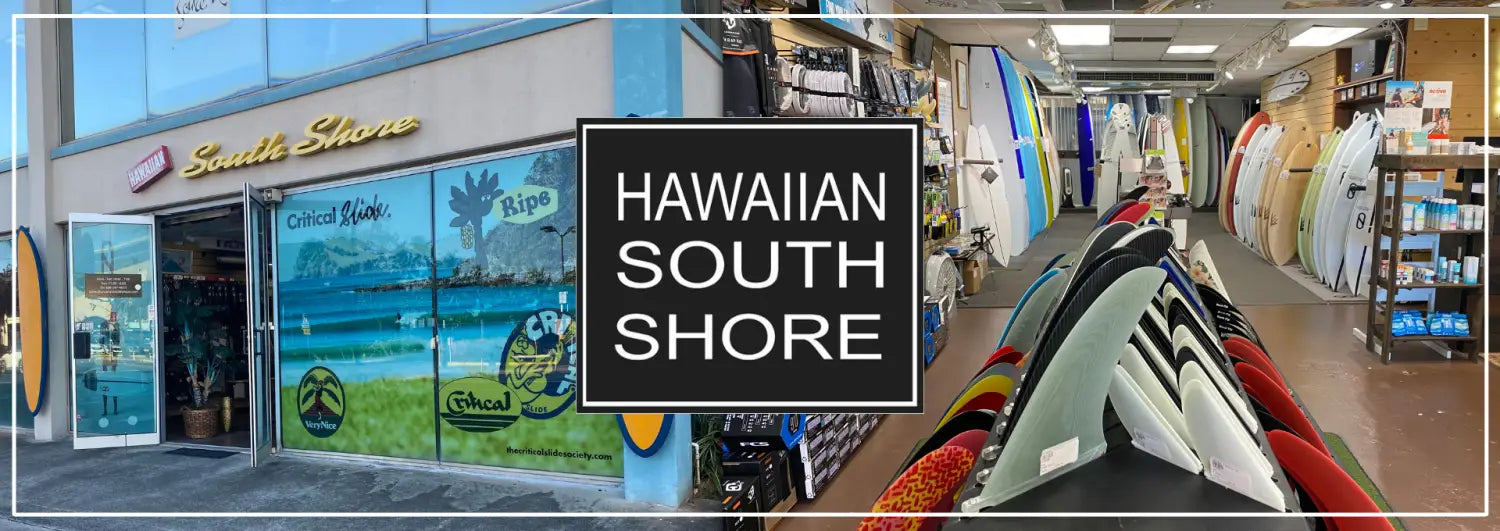Hawaiian South Shore March 2022 Newsletter Part 1 of 6 : How the Jet Stream and Ice Pack Affect Swell for the South Shore
Share
How the Jet Stream and Ice Pack Affect Swell for the South Shore

We surfers spend most of our time riding waves and thinking about riding waves, but not too much time thinking about where those waves come from. Although it might seem obvious in hindsight, many of us are unaware that swells are the direct result of the movement of wind on the surface of the water, and that those winds are affected by huge, global factors such as the Kelvin wave along the equator, the north and south jet streams, and even the ice mass down by Antarctica!
In terms of south swells for Oahu, we generally only get waves when large storms push north from Antarctica and send swell our direction. The way this works (in very simple terms) is that the westward movement of winds in the Kelvin wave along the equator feeds the jet stream down in the middle latitudes, making it stronger and allowing it to break out of a strictly west-to-east pattern and push north, making incursions into the tropics in what we call troughs.
To understand these troughs, first imagine a line of wind up at 30,000 feet that’s moving from above Australia toward southern Chile. If that wind (the jet stream) moves in a straight line, the energy of the wind doesn’t have an opportunity to move into the warmer water of the central Pacific, and thus is less likely to create major weather events. Now imagine that, instead of moving in a straight line, the jet stream is taking a wavy pattern, rising to the north then dipping south again, sometimes twice as the jet stream makes its way across the Pacific. These wavey, north-moving sections of the jet stream are called troughs, and they bring weather into the middle latitudes, where the water is warmer. Warmer water feeds storms, so when the jet stream has troughs, we are more likely to see low-pressure systems move into warmer water and become full-fledged storms. These storms generate wind and eventually (if they get big enough turn into gales, which create very strong wind that blows across the surface of the ocean.
As wind blows across the ocean’s surface, it whips the water up into waves. The stronger the wind and the longer it blows across the surface of the water, the bigger the waves get. These waves then propagate out across the surface of the ocean, generally moving in the direction that the wind was blowing as they were formed. The farther they travel, the smaller they get (this is called swell decay), since they loose energy as they move through the water. However, at the same time, these waves join together with other waves (due to the fact that some are moving faster than others), eventually creating sets of waves that have joined together and are moving at the same speed, and even becoming part of the same individual waves.

Photo from Surfline
Interestingly, although waves get smaller on the surface of the ocean the farther they travel, the joining of waves makes them more powerful, faster, and larger under the surface. We measure the period of these waves, which is the time it takes for two waves to pass the same point in the ocean. When waves are initially created by wind, they are very close together and unorganized, and their period is very short—usually between one to five seconds. The farther they travel, the more they join together and the bigger the gap between the waves. These longer-period waves move faster and extend further below the surface of the ocean. For instance, a swell with 12-second period (which is the upper range for wind swell) might only extend beneath the surface around 100 feet, while an 18-second swell (which we consider a long-period ground swell) extends nearly 1000 feet below the surface. Just imagine how much power there is in a 23-second swell!
There are mathematical calculations that allow us to predict the speed and power of a wave based on its period, and we can also use a somewhat generic formula to figure out how big a wave will be when it encounters the coast and breaks, taking into account both the period and the wave height. Remember, wave height decreases as the swell moves through the water, while period increases. So, the same swell that is 10 feet at 14 seconds when it hits Tahiti could be 5 at 17 in Hawaii and 1.5 feet at 24 seconds when it finally makes its way up to Alaska. The wave is getting smaller the farther north it goes (that is, the part we see above the surface is shorter), but it is also getting more powerful (that is, how far it extends below the surface increases, as does the speed).
The general, generic formula to figure out how big the waves will be when they hit the coastline is to multiply wave height by period and then divide by 10, which will give you the approximate breaking wave size in Hawaiian scale.
Bearing in mind that buoy readings only tell us the largest wave that comes through every hour, as well as the average period, we can assume that if we use buoy readings in our formula, our result will be the biggest wave to come through each hour. In our Tahiti/Hawaii/Alaska example above, Tahiti would expect to see around a 14-foot set (10 feet x 14 seconds = 140; divided by 10 equals 14 foot). Oahu would expect to see around an 8-foot wave (5 feet x 17 seconds = 85; divided by 10 equals around an 8-foot wave); and Alaska might only see a 3- to 4-foot wave (1.5 feet x 24 seconds = 36; divided by 10 equals 3.6 feet).
Of course, this is only a generic formula, and it is also important to take into account local bathymetry where the wave ends up breaking. For example, the sea floor of the North Shore drops off more abruptly than the sea floor on the South Shore, and abrupt changes in depth tend to create more powerful waves. (Think of the wave traveling 1000 feet underwater and abruptly slamming into a vertical wall of seafloor, as opposed to a gradual, sloping seafloor. The vertical wall would cause the wave to abruptly and violently pitch over, while the gradual sloping sea floor would cause the wave to slowly stand up and eventually break, draining energy away from it while doing so. Hence, Waimea Bay and Pipeline are slabby and hollow, while Waikiki is a soft burger). Taking all of this into account, a 5-foot at 17-second swell on the North Shore will typically come in more powerful than a swell of the same size on the South Shore.
While this explanation might suggest that a bigger swell with longer period is always best, there are exceptions to this rule. Some waves simply can’t handle the speed and power of long—period waves and tend to close out or shut down when the period gets too long. Beach breaks are a great example, as they tend to be peakier on shorter periods and more walled up on long periods.
Another factor to consider is the depth at which a wave travels below the surface, and how this interacts with the bathymetry. Waimea Bay is a great example. Shorter-period waves sweep straight into Waimea Bay, while longer-period waves that extend hundreds and even thousands of feet beneath the surface feel the nearby outer reefs and are bent away from the mouth of The Bay, so not as much energy gets in. Hence, even though it’s counterintuitive, a 15-second swell tends to be better for Waimea, while a 20-second swell will be much bigger on the outer reefs than it is in The Bay.
When it comes to swells for the South Shore, there’s another interesting factor at place. Remember, waves are generated by wind blowing over the surface of the water. Thus, to get a big swell, we want a lot of wind blowing over a large period of water. But if there’s less surface area for the wind to blow over, there is less “fetch” (the distance the wind blows over the water in a certain direction) and less opportunity for waves to develop. As crazy as it might sound, the South Pacific can actually get smaller during really cold winters (bearing in mind that winter in the Southern Hemisphere is June through August) when the ice pack down by Antarctica gets bigger. If the ice pack is covering more of the ocean than usual, that means less liquid water for the wind to blow across, which means smaller areas where swell-generating storms can develop and create waves. Thus, when the Antarctic ice pack is bigger than normal, we are less likely to get south swells on Oahu. And as mentioned earlier, when the jet stream is weak and moving in a straight line rather than developing troughs, we are also less likely to get swells.
So, what are the perfect ingredients for a strong south swell season for Oahu? A small ice pack, a strong jet stream with lots of trough, warm water in the middle and tropical latitudes, and storm generation in our window (which is typically just west of New Zealand. If you see that on the weather models, get your boards waxed up and ready to go!
What's NEW at Hawaiian South Shore

The 83 board shorts should be a staple in every surfer's closet. A timeless style paired with the finest materials and details.


